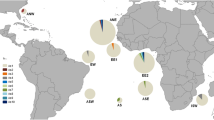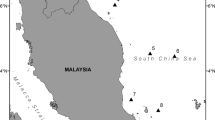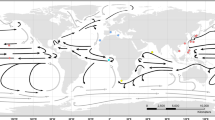Abstract
Despite Springer’s (1964) revision of the sharpnose sharks (genus Rhizoprionodon), the taxonomic definition and ranges of Rhizoprionodon in the western Atlantic Ocean remains problematic. In particular, the distinction between Rhizoprionodon terraenovae and R. porosus, and the occurrence of R. terraenovae in South American waters are unresolved issues involving common and ecologically important species in need of fishery management in Caribbean and southwest Atlantic waters. In recent years, molecular markers have been used as efficient tools for the detection of cryptic species and to address controversial taxonomic issues. In this study 415 samples of the genus Rhizoprionodon captured in the western Atlantic Ocean from Florida to southern Brazil were examined for sequences of the COI gene and the D-loop and evaluated for nucleotide differences. The results on nucleotide composition, AMOVA tests, and relationship distances using Bayesian-likelihood method and haplotypes network, corroborates Springer’s (1964) morphometric and meristic finding and provide strong evidence that supports consideration of R. terraenovae and R. porosus as distinct species.





Similar content being viewed by others
References
Abercrombie DL, Clarke SC, Shivji MS (2005) Global-scale genetic identification of hammerhead sharks: application to assessment of the international fin trade and law enforcement. Conserv Genet 6:755–788
Aljanabi SM, Martinez I (1997) Universal and rapid salt-extraction of high quality genomic DNA for PCR-based techniques. Nucleic Acids Res 25:4692–4693
Bigelow HB, Schroeder WC (1948) Fishes of the western North Atlantic. Part one. Lancelets cyclostomes, sharks. Sears Foundation for Marine Research, Yale University, New Haven, p 576
Carlin JL, Robertson DR, Bowen BW (2003) Ancient divergences and recent connections in two tropical Atlantic reef fishes Epinephelus adscensionis and Rypticus saponaceous (Percoidei: Serranidae). Mar Biol 143:1057–1069
Clement M, Posada D, Crandall KA (2000) TCS: a computer program to estimate gene genealogies. Mol Ecol 9:1657–1660
Compagno LJV (1984) FAO species catalogue vol. 4, Part 2 Sharks of the world. An annotated and illustrated catalogue of shark species known to date. FAO Fish Synop 125:251–255
Corrigan S, Huveneers C, Schwartz TS, Harcourt RG, Beheregaray LB (2008) Genetic and reproductive evidence for two species of ornate wobbegong shark Orectolobus spp. on the Australian east coast. J Fish Biol 73:1662–1675
De-Franco B, Mendonça FF, Hashimoto DT, Porto-Foresti F, Oliveira C, Foresti F (2009) Forensic identification of the guitarfish species Rhinobatos horkelli, R. percellens, and Zapteryx brevirostris using multiplex-PCR. Mol Ecol Resour 10:197–199
Excoffier L, Smouse P, Quattro J (1992) Analysis of molecular variance inferred from metric distances among DNA haplotypes: application to human mitochondrial DNA restriction data. Genetics 131:479–491
Excoffier L, Laval G, Schneider S (2005) ARLEQUIN ver. 3.0: an integrated software package for population genetics data analysis. Evol Bioinform Online 1:47–50
Gadig OBF (2001) Tubarões da Costa Brasileira. Tese de Doutorado, Unesp, Campus de Rio Claro, São Paulo, p 343
Hasegawa M, Kishino K, Yano T (1985) Dating the human-ape splitting by a molecular clock of mitochondrial DNA. J Mol Evol 22:160–174
Hebert PDN, Ratnasingham S, DeWaard JR (2003) Barcoding animal life: cytochrome oxidase subunit 1 divergences among closely related species. Proc R Soc B 270:S96–S99
Hoelzel AR, Hancock JM, Dover GA (1991) Evolution of the cetacean mitochondrial D-loop region. Mol Biol Evol 8:475–493
Huelsenbeck JP, Ronquist F (2001) MrBayes: Bayesian inference of phylogenetic trees. Bioinformatics 17:754–755
Lopez JV, Culver M, Stephens JC, Johnson WE, O’ Brien SJ (1997) Rates of nuclear and cytoplasmic mitochondrial DNA sequence divergence in mammals. Mol Biol Evol 14:277–286
MacVector™ 6.5 (1998) Oxford Molecular Ltd, Oxford, UK
Mariguela TC, De-Franco B, Almeida TVV, Mendonça FF, Gadig OBF, Foresti F, Oliveira C (2009) Identification of guitarfish species Rhinobatos percellens, R. horkelli, and Zapteryx brevirostris (Chondrichthyes) using mitochondrial genes and RFLP technique. Conserv Genet Resour 1:393–396
Mendonça FF, Hashimoto DT, Porto-Foresti F, Oliveira C, Gadig OBF, Foresti F (2009a) Identification of the shark species Rhizoprionodon lalandii and R. porosus (Elasmobranchii, Carcharhinidae) by multiplex PCR and PCR-RFLP techniques. Mol Ecol Resour 9:771–773
Mendonça FF, Oliveira C, Gadig OBF, Foresti F (2009b) Populations analysis of the Brazilian Sharpnose Shark Rhizoprionodon lalandii (Chondrichthyes: Carcharhinidae) on the São Paulo coast, southern Brazil: inferences from mt DNA sequences. Neotrop Ichthyol 7(2):213–216
Meyer CP, Paulay G (2005) DNA barcoding: error rates based on comprehensive sampling. Plos Biol 3:2229–2238
Meyer A, Kocher TD, Basasibwaki P, Wilson AC (1990) Monophyletic origin of Lake Victoria cichlid fishes, suggested by mitochondrial DNA sequence. Nature 347(11):550–553
Moura T, Silva MC, Figueiredo I, Neves A, Muñoz PD, Coelho MM, Gordo LS (2008) Molecular barcoding of north-east Atlantic deep-water sharks: species identification and application to fisheries management and conservation. Mar Freshw Res 59:214–223
Murgra B, Tola G, Archer SN, Vallerga S, Hirano J (2002) Genetic identification of grey mullet species (Mugilidae) by analysis of mitochondrial DNA sequence: application to identify the origin of processed ovary products (Bottarga). Mar Biotechnol 4:119–126
Posada D, Crandall KA (1998) Modeltest: testing the model of DNA substitution. Bioinformatics 14:817–818
Quattro J, Stoner D, Driggers W, Anderson C, Priede K, Hoppmann E, Campbell N, Duncan K, Grady J (2006) Genetic evidence of cryptic speciation within hammerhead sharks (Genus Sphyrna). Mar Biol 148:1143–1155
Rice WR (1989) Analyzing tables of statistical tests. Evolution 43:223–225
Rocha LA, Robertson DR, Roman J, Bowen BW (2005) Ecological speciation in tropical reef fishes. Proc R Soc B 272:573–579
Rocha-Olivares A, Rosenblatt RH, Vetter RD (1999) Molecular evolution, systematics, and zoogeography of the Rockfish subgenus Sebastomus (Sbastes Scorpaenidae) based on mitochondrial cytochrome b and control region sequences. Mol Phylogenet Evol 11(3):441–458
Ronquist F, Huelsenbeck JP (2003) MrBayes 3: Bayesian phylogenetic inference under mixed models. Bioinformatics 19:1572–1574
Sandoval-Castillo J, Rocha-Olivares A, Villavicencio-Garayzar C, Balrt E (2004) Cryptic isolation of Gulf of California shovelnose guitarfish evidenced by mitochondrial DNA. Mar Biol 145:983–988
Shivji MS, Clarke S, Pank M et al (2002) Genetic identification of pelagic shark body parts for conservation and trade monitoring. Conserv Biol 16:1036–1047
Smith WD, Bizzarro JJ, Richards VP, Nielsen J, Marquez-Farias F, Shivji MS (2009) Morphometric convergence and molecular divergence: the taxonomic status and evolutionary history of Gymnura crebripunctata and Gymnura marmorata in the eastern Pacific Ocean. J Fish Biol 75:761–783
Sneath PHA, Sokal RR (1973) Numerical taxonomy. Freeman, San Francisco, CA
Springer VG (1964) A revision of the carcharhinid shark genera Scoliodon, Loxodon, and Rhizoprionodon. Proc US Natl Mus 115:559–632
Swofford DL (2004) PAUP—phylogenetic analysis using parsimony and other methods, version 4. Sinauer Associates, Sunderland, MA
Tamura K, Nei M (1993) Estimation of the number of nucleotide substitutions in the D-loop of mitochondrial DNA in humans and chimpanzees. Mol Biol Evol 10:512–526
Tamura K, Nei M, Kumar S (2004) Prospects for inferring very large phylogenies by using the neighbor-joining method. Proc Natl Acad Sci USA 101:11030–11035
Tamura K, Dudley J, Nei M, Kumar S (2007) MEGA 4: Molecular Evolutionary Genetics Analysis (MEGA) Software version 4.0. Mol Biol Evol 24:1596–1599
Templeton AR, Crandall KA, Sing CF (1992) A cladistic analysis of phenotype associations with haplotypes inferred from restriction endonuclease mapping and DNA sequence data. III. Cladogram estimation. Genetics 132:619–633
Ward RD, Zemlak TS, Innes BH, Last PR, Hebert PDN (2005) DNA barcoding Australia’s fish species. Philos Trans R Soc B 360:1847–1857
Ward RD, Holmes BH, White WT, Last PR (2008) DNA barcoding Australasian chondrichthyans: results and potential uses in conservation. Mar Freshw Res 59:57–71
Acknowledgments
This study was funded by FAPESP—Fundação de Amparo à Pesquisa do Estado de São Paulo (grant no. 06/588972) and CNPq—Brazilian Council for Technological and Scientific Development (grant no. 308439/2006-6). We thank those who collaborated by collecting sharpnose shark specimens and tissue samples, especially Dr. Jason Romine, Msc. Johanna Imhoff, Msc. Ernesto Ron, Dra. Iracilda Sampaio, Msc. Hugo Bornatowski, and the Projeto Cação team Dr. Fábio dos Santos Motta and Dr. Rafael Cabrera Namora.
Author information
Authors and Affiliations
Corresponding author
Rights and permissions
About this article
Cite this article
Mendonça, F.F., Oliveira, C., Burgess, G. et al. Species delimitation in sharpnose sharks (genus Rhizoprionodon) in the western Atlantic Ocean using mitochondrial DNA. Conserv Genet 12, 193–200 (2011). https://doi.org/10.1007/s10592-010-0132-6
Received:
Accepted:
Published:
Issue Date:
DOI: https://doi.org/10.1007/s10592-010-0132-6




